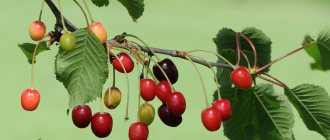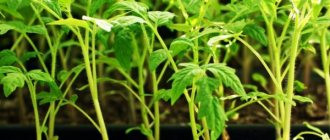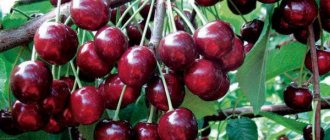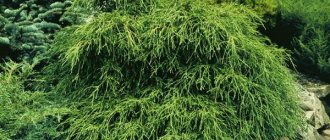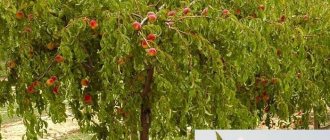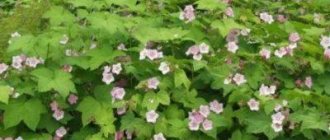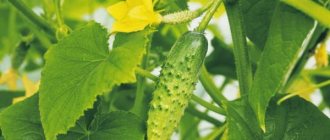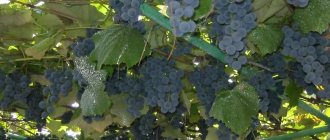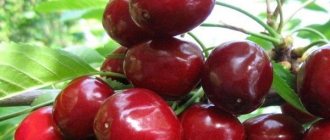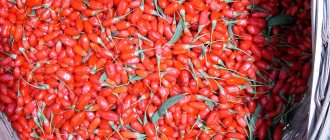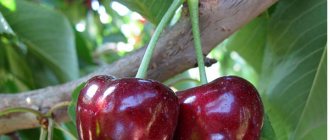History of the variety
In fact, the true history of the Franz Josef cherry variety is completely unknown. Records about it have not reached us, since the age of this cherry is already quite old, and the information could well be lost for centuries.
However, historians suggest, based on the name of the cherry - Franz Joseph - that the variety could have been bred for or in honor of the Austrian emperor of the same name.
Presumably, the creator of the variety was the then famous scientist-breeder Joseph-Eduard Prohe, who devoted many years of his life to studying the varieties of this particular tree. The Franz Josef cherry variety was brought to Russia not from Austria, but from the Czech Republic, since it was in this country that by the beginning of the nineteenth century cherries were not the most common.
However, another century and a half passed from that day until the variety was officially included in the state register.
Pollination
Very often, having planted a high-yielding variety of cherries on their plot, inexperienced gardeners are surprised why the tree does not begin to bear fruit. And the reason is banally simple: cherries cannot be pollinated.
Important! Despite the fact that recently breeders have been trying to develop self-fertile varieties of cherries, they are still very rare.
As a rule, cherry is a cross-pollinated tree, which requires pollinators planted nearby for normal productivity, and not just any pollinators, but strictly defined ones, suitable for this particular variety.
The Franz Joseph cherry, unfortunately, is no exception. Its fruit sets better when planted nearby with other varieties of cherries. The best pollinators for it are : “Zhabule”, “South Naberezhnaya red”, “Drogana yellow”, “Dibera black”, “Biggaro Goshe”, “Cassina early”, “Golden”, “Biggaro Grollya”, “Gedelfingen”, “Denissena” yellow."
However, it should be said that even with such joint planting, sometimes it is not possible to achieve a good harvest. If such a problem arises, experienced gardeners advise resorting to a “last resort” - hand pollination.
Important! Artificial pollination
is a troublesome task, but it has two undeniable advantages: it ensures the highest possible yield (the fruit will set in almost every flower place) and, in addition, protects the tree from harmful diseases carried by pollinating insects (if, of course, you will use clean tools).
The technology of hand pollination is the topic of a separate article; we will not dwell on it in detail here; our task is only to reassure the unfortunate summer residents who have planted the high-yielding “Franz Joseph” on their plot and are not receiving the expected return from the tree.
Cherry Franz Joseph: description of the variety
Cherry Franz Joseph: photo of the variety
The Franz Joseph cherry tree has quite impressive dimensions, and its crown has a rather weakly expressed geometric oval shape. The density of the crown is average.
The leaves have an egg-shaped shape typical of fruit plants, and their edges are slightly pointed. The tip of the leaf is also pointed (on both sides), which makes them slightly elongated.
As for the fruits, which are much more interesting to our readers, they have a very beautiful shape, slightly flattened on the sides. Their groove is very well defined, and the color varies as they bloom from yellowish to bright red. However, the berries never turn completely red, and yellow spots remain on them.
The pulp, however, does not turn red as the berries grow, and therefore even in fully ripened fruits it is bright yellow and, at the same time, of course, incredibly juicy and tasty.
The taste itself can be described as a perfect balance of sour and sweet, the absence of which distinguishes bad varieties from good ones.
The plant is cultivated almost everywhere: in Russia, Ukraine, Moldova and throughout Central Asia. However, this variety grows best on the territory of the Rat Peninsula, because it is there that nature has created the best conditions for its growth.
Variety: Cherry – Francis
Variety: Cherry – Francis
The variety originated at the end of the 19th century; according to the current version, it was bred in the Czech Republic by pomologist I. Proche. Zoned in the North Caucasus region since 1974.
The tree is vigorous, with a sparse, broadly oval crown. The leaves are large 150 x 75 mm, oval or obovate, petioles of average length 27 mm, thick, with an anthocyanin tan. Flowers are usually 3 in an inflorescence, 30 mm, with oval petals, a goblet-shaped calyx and a style rising above the anthers. The fruits are large, weighing 6-7 g, wide-heart-shaped, with a wide, spacious funnel, creamy yellow with a bright red blush, occupying 3/4 of the surface of the fruit. The pulp is dense, gristly, light yellow, very good harmonious taste, contains: dry matter 17.6%, sugars 12.9%, free acids 0.6%, ascorbic acid 5.6 mg/100g wet weight. A medium-sized stone (10.5 x 8.5 x 6.5 mm), weighing 0.4 g, semi-lagging, oval or broadly ovoid, makes up 6% of the total weight of the fruit. The peduncle is of average length 34 mm, quite thick and firmly attached to the fruit. Plants begin to bear fruit in the 5th year. Flowering occurs in the early stages, ripening in the middle (3rd decade of June). The best pollinating varieties can be Gedelfingen, Bigarro Gaucher, Bigarro Grollya, Drogana yellow, Denissena yellow, Zolotaya, Zhabule, Daibera black, Cassina early. The winter hardiness of the variety is quite satisfactory: at -24°C, 52% of the flower buds are damaged, and no freezing of the wood was detected. In severe winters, damage to trunks and skeletal branches is observed. Damage caused by fungal diseases reaches on average: for coccomycosis - 2.5 (max. 4), moniliosis - 1.0 (max. 3), clasterosporiasis - 2.1 points (max. 3). The potential productivity of the variety is high: in Crimea, the average yield per tree over 9 years of full fruiting was 113 kg, the maximum was 249 kg. In the foothills of the North Caucasus, the maximum yield of a tree at 12 years of age was 30 kg. In Ukraine, trees produce 60-70 kg of fruit. Francis is an excellent industrial variety; its fruits are good for fresh consumption and produce high-quality processed products. They are suitable for transportation. Advantages: high-quality marketable fruits, high productivity and good transportability, good winter hardiness of vegetative organs. Disadvantages: during wet ripening seasons, fruits are prone to cracking and gray rot.
wiki.agro-sales.ru
Cherry Franz Joseph: characteristics of the variety
Cherry Franz Joseph: photo of the variety
Franz Josef cherries have been specially developed to be the most convenient and useful in industrial production, and therefore their characteristics may seem unusual, since they are very different from most varieties on the market.
- Drought and frost resistance
Perhaps the most important advantage of the Franz Joseph cherry variety is its adaptability to changing weather conditions, which include both dry periods and sudden cold snaps.
In fact, it should be noted that the tree’s drought resistance is so developed that even with a lack of moisture, it will not only grow and live normally, but also fully bear fruit. However, moisture is still needed for growth and to maintain the plant's ability to produce fruit quickly, which can be damaged by particularly prolonged drought.
But with frosts, the situation is somewhat more ambiguous, since the tree can fight the cold no less well than the lack of moisture, but it will have to spend a little more time recovering from a particularly cold winter than some other varieties.
- Cherry pollinators Franz Joseph
Surely, the name of this point frightened many gardeners, and for good reason, because most of us like to grow exclusively self-sufficient plants that can consistently produce fruit without pollinators.
However, Franz Josef cherries, unfortunately, are not one of these. After all, given her amazing qualities, one would expect her to have similar disadvantages.
Moreover, it is worth noting that without a pollinator, this cherry is absolutely self-sterile, and therefore it will not only give you less fruit, but will not produce any at all, so you will definitely have to take care of the pollinator.
The best pollinators for Franz Josef cherries are varieties such as Napoleon, Jaboulet or Drogana Zheltaya. These crops have the same fruiting periods as Franz Joseph cherries, and are also similar to the variety under discussion in other qualities.
However, there is still an alternative: you can try a hand pollination procedure, which will allow you to get the maximum yield from your cherries without even thinking about planting a pollinator.
However, this procedure can be incredibly costly and troublesome, as well as incredibly complicated, and therefore we strongly do not recommend it to you if you have only recently started gardening and have not yet delved into all the intricacies of the processes.
For those who still decide to carry out manual pollination, let’s say that bees are best attracted to a honey solution, and therefore it is advisable to use it.
By the way, speaking about the timing of fruiting: the Franz Joseph cherry variety begins to bear berries only at the end of June, which is quite a late date for cherries. This happens because the plant loves heat very much and is able to ripen only under the hot rays of the sun.
- Productivity and fruiting of the Franz Joseph variety
Since the variety was bred for production purposes, of course, its yield should be superior to other varieties. However, the numbers shown by the Franz Joseph cherry variety are simply incredible, because on average one of its trees produces no less than two or even three times more berries than others.
However, such numbers are, of course, achieved through hard work, good care, and also due to some random factors such as weather conditions.
However, you will be able to get such stunning harvests in at least four years, since only after this time the variety reaches fruiting age, and you will also have to wait a couple more years for the trees to reach the peak of their fertility.
So, to summarize, we can say that, with enough effort, you can get a truly royal harvest only after eight, or even seven years.
- Application of berries
As you already know, the fruits of this variety of cherries have exceptional taste, and therefore they are suitable both for consumption raw and for use as an ingredient for preparing dishes and preparations for the winter.
Also, many gardeners claim that the method of preparing berries by drying is not only original, but also very effective, since the result is incredibly tasty and even better than dried apricots and raisins.
However, there is also an area of application for which this cherry is completely unsuitable, and this is freezing. Unfortunately, when berries go through prolonged cold treatment, they completely lose their sugar content, juiciness and taste.
- Resistance to diseases and pests
In fact, not only this variety, but cherries in general are much less susceptible to attacks by insects and pests than, for example, cherries.
In addition, the Franz Joseph variety itself has an innate resistance to many fungal diseases, but this still does not mean that this plant is invulnerable. It, of course, has weaknesses and can get sick, and therefore we strongly recommend that you carry out preventive spraying.
Variety: Cherry
The variety originated at the end of the 19th century; according to the current version, it was bred in the Czech Republic by pomologist I. Proche. Zoned in the North Caucasus region since 1974.
The tree is vigorous, with a sparse, broadly oval crown. The leaves are large 150 x 75 mm, oval or obovate, petioles of average length 27 mm, thick, with an anthocyanin tan. Flowers are usually 3 in an inflorescence, 30 mm, with oval petals, a goblet-shaped calyx and a style rising above the anthers.
The fruits are large, weighing 6-7 g, wide-heart-shaped, with a wide, spacious funnel, creamy yellow with a bright red blush, occupying 3/4 of the surface of the fruit. The pulp is dense, gristly, light yellow, very good harmonious taste, contains: dry matter 17.6%, sugars 12.9%, free acids 0.6%, ascorbic acid 5.6 mg/100g wet weight. A medium-sized stone (10.5 x 8.5 x 6.5 mm), weighing 0.4 g, semi-lagging, oval or broadly ovoid, makes up 6% of the total weight of the fruit. The peduncle is of average length 34 mm, quite thick and firmly attached to the fruit.
Plants begin to bear fruit in the 5th year. Flowering occurs in the early stages, ripening in the middle (3rd decade of June). The best pollinating varieties can be Gedelfingen, Bigarro Gaucher, Bigarro Grollya, Drogana yellow, Denissena yellow, Zolotaya, Zhabule, Daibera black, Cassina early. The winter hardiness of the variety is quite satisfactory: at -24°C, 52% of the flower buds are damaged, and no freezing of the wood was detected. In severe winters, damage to trunks and skeletal branches is observed. Damage caused by fungal diseases reaches on average: for coccomycosis - 2.5 (max. 4), moniliosis - 1.0 (max. 3), clasterosporiasis - 2.1 points (max. 3).
The potential productivity of the variety is high: in Crimea, the average yield per tree over 9 years of full fruiting was 113 kg, the maximum was 249 kg. In the foothills of the North Caucasus, the maximum yield of a tree at 12 years of age was 30 kg. In Ukraine, trees produce 60-70 kg of fruit.
Francis is an excellent industrial variety; its fruits are good for fresh consumption and produce high-quality processed products. They are suitable for transportation.
Advantages: high-quality marketable fruits, high productivity and good transportability, good winter hardiness of vegetative organs.
Disadvantages: during wet ripening seasons, fruits are prone to cracking and gray rot.
vniispk.ru
Franz Joseph cherries: advantages and disadvantages
Cherry Franz Joseph: photo of the variety
As you may have noticed, the Franz Josef cherry really got its status for a reason, because its taste really exceeds all expectations, and its physiological characteristics are ideal for breeding the crop on an industrial scale.
However, growing Franz Joseph cherries at home in small quantities is also a great idea, and the fruits can be used both as treats for relatives and for sale, which will significantly expand the family budget.
However, of course, this plant also has disadvantages, the main one of which is the fact that cherries are not capable of self-pollinating, and therefore you will have to either plant a pollinator or resort to a rather difficult procedure of manual pollination.
Also, the plant is in dire need of pruning, since the natural shape of the crown eventually falls into an extremely deplorable state. In addition, no one has canceled sanitary trimmings either.
Cherry Franz Joseph: planting varieties
Cherry Franz Joseph: photo of the variety
Of course, if you want your tree to grow efficiently and be as healthy and strong as possible, you will need to put a lot of effort into planting it correctly. After all, it’s not for nothing that professional gardeners say that good planting is half the success of a tree.
Therefore, we invite you to read the detailed instructions on how to plant this tree, and also give you a couple of useful tips. Let's start, of course, with the time of landing.
- Recommended timing
Most often, like any other fruit plant, cherries are planted in the spring. This is done so that before the onset of cold weather, the tree has time to form a powerful root system, which will allow it to survive the winter calmly.
In addition, good weather and bright sun will have an extremely positive effect on the tree in the coming summer, and therefore the tree will be able to develop and grow much better, preparing for future fruiting.
- Choosing a landing site
Franz Josef cherry is a plant that cannot tolerate excess moisture, and therefore it should never be planted in the lowlands, since it is there that absolutely all the water will collect during rains.
Therefore, hills or flat surfaces, which will certainly be found on your site, are best suited for planting.
You should also make sure that the plant receives enough sunlight, as this is the most important factor in the early years of the cherry tree, when the tree has yet to grow.
Don’t forget that you will have to choose the right soil, which means that clay or sandy soil should under no circumstances predominate in the place where you plant cherries.
Instead of such unsuitable soils, it is advisable to use exclusively fertile and high-quality soils, which will also be neutral in acidity level, since only in such conditions can the plant express itself at its best.
Just like high humidity, the tree will be very badly affected by the use of excessive amounts of fertilizers, and therefore, when applying them, you need to carefully calculate the dosage.
- Cherry Neighbors Franz Joseph
As you probably know, proximity is a fairly important aspect of growing many different crops on one site. In the case of such settlement, it is necessary to take into account absolutely everything, and also the fact that some cultures do not interact with each other at all, and some may form “cooperations”.
In any case, as you already know, you will have to plant a pollinator along with this cherry variety. We have already talked about which varieties are suitable for this role.
But fruit plants such as apple trees or pears can become unsuitable neighbors for Franz Josef cherries. Plum can also have a strong negative impact.
- Selection and preparation of seedlings
Perhaps there is no need to explain that only a good seedling can grow into a good tree, and therefore you will have to carefully select planting material.
First of all, you must understand that you should treat sellers with at least a degree of skepticism, since there are a huge number of fakes and ordinary wild cherries on the markets, but in three or four years, when the truth is revealed, you will not be able to prove the deception .
Therefore, the best way to make sure that the seller is providing you with a truly high-quality product is to ask him to provide his documents for this plant. If there are any, then in this case you should find out more about the seedling itself.
After making sure that the product you are buying is indeed a varietal one, you must also pay attention to the age of the seedling: it should be about three years old, and it should also have a relatively large number of branches.
It is also advisable to discard the seedling if you notice obvious damage to the root, which is physical or resulting from a disease.
Also, after purchasing, you should remember to follow the transportation rules, as this process can be incredibly stressful for the tree.
- How to plant cherries?
Now that you have chosen the timing of planting, the location of planting and even the seedling that will soon be in the ground, it still remains to carry out the most difficult upcoming procedure - the planting itself, during which you must be the most careful and concentrated.
Preparations must begin in the fall: the soil in the place where you are going to plant the plant must be fertilized with a bucket of compost and, if possible, chemical fertilizers. Also, if your soil is overly acidic, it needs to be treated with wood ash.
Already in the spring - directly at the time of planting - it is necessary to dig a hole, the diameter of which will be eighty centimeters and the depth - fifty centimeters. In this case, it is necessary to loosen the bottom a little so that it is easier for the roots of the tree to take root in it.
The seedling must be placed in the hole so that its roots are evenly distributed along the bottom.
After this, the roots are covered with soil. In this case, you need to make sure that each layer that you spread is thoroughly compacted, since otherwise air bubbles may form, which can cause rotting of the roots.
All branches of already planted cherries should be shortened by a third in order to control crown growth.
After all the above tips, you need to water the seedling well.
And, of course, the most important thing is to be careful throughout the entire process. And in order not to make unnecessary mistakes, you need to relax and not stress.
Landing Features
Planting cherries must be carried out at a certain time according to a special scheme, having prepared for it in advance. In order for the plant to grow, you need to choose the right planting material and place of its growth.
Recommended timing
Planting must be done in early spring so that the tree has time to take root well before the onset of cold weather, and sunny weather affects the rate of growth and development of the Franz Joseph cherry.
Choosing a suitable location
It is advisable to plant Franz Josef cherries at higher elevations, closer to the south, in direct sunlight. Soil with a large amount of sand, stones and clay will negatively affect the development of the seedling and will greatly slow down its development. High humidity and the application of excessive fertilizers will also have a bad effect on the condition of the fruit. It is necessary to choose high-quality fertile soil with a normal content of organic and inorganic substances.
What crops can and cannot be planted nearby?
Franz Josef cherries need pollinators, so it is worth planting varieties suitable for this nearby. The presence of nearby fruit trees such as plum, pear and apple trees will have a bad effect on the growth and development of the crop.
Selection and preparation of planting material
In order not to make a mistake in choosing a quality cherry seedling, you should ask the seller if there are documents for the plant. The seedling must be three years old and have many branches. If dark spots or dry areas are noticed on root sections, you should not purchase a seedling. When transporting, the root system should be wrapped in a damp cloth.
Landing algorithm
The speed of growth and development of the seedling depends on the correct planting, so it is worth carefully studying the sequence of actions when planting Franz Joseph cherries:
- In the fall, fertilize the soil with a bucket of compost and ash; if desired, you can use chemical fertilizers.
- Dig a hole 80 cm wide, 50 cm deep and loosen the bottom using a crowbar.
- Place the seedling, carefully straightening the roots.
- Carefully compacting each new layer of soil, fill the root system of the cherry tree.
- Shorten the branches by a third.
- Water the tree well.
Cherry Franz Joseph: variety care
Cherry Franz Joseph: photo of the variety
An incredibly important procedure that should be carried out regularly is pruning. In the first few years, formative pruning will be especially important.
It consists of shortening all the forming branches by one fifth, and then thoroughly treating all the cuts with garden varnish. Do not forget that pruning is a process that involves deliberately causing harm to the plant, and therefore, in order to mitigate the damage, it is necessary to use only well-sharpened tools.
As for watering, they should be avoided only in rainy weather. At all other times, despite its resistance to drought, the plant must consistently receive the moisture it needs. This is done when the tree trunk circle around the plant dries out very much. In this case, you will need about two buckets of clean and slightly heated water.
Also, in addition to water, it is necessary to introduce fertilizers into the soil, which will stimulate proper growth and development. The most important thing is not to exceed the dosage recommended by the manufacturer, and also try not to mix mineral fertilizers with organic ones.
However, it is still advisable to use both types of fertilizers, but alternating them, since the tree must receive absolutely all the elements it needs.
- Preparing for winter
We have already told you that the Franz Josef cherry variety, although it can withstand frost, has huge problems with restoring to a healthy state after long winters. That is why thoroughly preparing for the winter season is simply necessary.
The best protection for the root system from the cold, as well as the simplest and most affordable, is whitewashing the trunk, which should be done in spring and autumn. Also, in addition to the trunk, it is advisable to paint the skeletal branches, since their bases are also very exposed to the cold.
In addition, do not forget that immediately after winter, whole hordes of rodents will begin to appear from under the ground, from which you will need thorough protection.
Also, phosphorus fertilizers can greatly help you in protecting you from cold and frost, which will make this period not so painful for the tree.
Diseases and pests
As we have already told you, Franz Josef cherries are quite well protected from the most dangerous diseases. However, she still gets sick, which, unfortunately, is inevitable, and therefore you will have to take care to protect her with preventative methods from all kinds of infections.
This is especially true during periods of excessively wet weather, when diseases are at their greatest.
- Moniliosis
This disease manifests itself as follows: leaves and flowers begin to gradually become covered with brown spots, as a result of which they completely become brown and dried out. This leads to irreversible rotting and falling off.
In order to completely prevent the occurrence of this disease, it is necessary to make sure at the planting stage that the place where you are planting the plant is well ventilated. Good pruning also helps in disease prevention. Cleaning the soil along with fertilizing it will also not be necessary.
If the disease has already occurred and needs to be gotten rid of immediately, all affected parts of the plant are completely removed and destroyed. It is also necessary to treat the cherries with Bordeaux mixture, which will prevent the return of the disease.
- Clusterospirosis
The disease begins to progress in the same way as the previous one: spots appear on the leaves and other vegetative parts of the plant, which over time grow and progress into holes. As a result, the affected part of the plant dies completely.
In order to avoid this unpleasant disease, it is enough just to fertilize the plant well, and also be very careful to ensure that weeds do not spread around.
If it was not possible to prevent the infection, then you will have to resort to treating the plant with Bordeaux mixture and, as in the previous case, to the complete destruction of all infected chats.
- Coccomycosis
This fungal disease manifests itself with the same signs that we could observe in the two previous cases: small brown spots appear on the leaves of the plant, which grow strongly over time and eventually take over the cherry.
Despite the strong similarity, this particular disease is the most dangerous, since it is as a result of it that plants most often die.
In order to protect yourself from coccomycosis, you will have to constantly remove fallen leaves from under the cherries so that they do not become infected, and also loosen the soil, which may contain dormant fungi.
Another method of prevention is to add copper sulfate to whitewashing products, which will become another level of protection for your tree.
In case of infection, if it is not too late, you can overcome the disease by treating the cherries with a solution of copper sulfate (about a hundred grams per ten liters of water)
- Black aphid
It is aphids that are one of the most irritable insects, which, nevertheless, are undoubtedly present in absolutely every garden.
In order to protect your plants from it, you will have to promptly remove weeds that form in the tree trunk, and also thoroughly loosen the soil.
If the parasite has already infested your tree, you need to take measures: in case of a minor attack, you can get by with an absolutely safe soap solution, but if the aphid attack is massive, you will have to use an insecticidal preparation. Also, some plants can cope with aphids by repelling them with their secretions.
- cherry fly
Despite its name, this small insect can cause considerable harm to cherries, and therefore, in order for it not to cause you absolutely any trouble, you need to collect them as the fruits fall, and also thoroughly loosen the soil.
However, if a cherry fly starts, it will be quite easy to defeat it, since it is afraid of ordinary insect traps and simple insecticides.
- Pipe screwer
This insect can also be very annoying to those who are going to grow Franz Josef cherries. In order to prevent its appearance, you will have to constantly get rid of weeds that appear around the plant, as well as pick up fallen berries.
These insects are the easiest to combat, despite the fact that, compared to the previous ones, they pose a greater danger to kuja in the absence of proper supervision. In order to temporarily get rid of tubeworms, you just need to shake the tree thoroughly, but in the long term, they get rid of them using chemical means.
By the way, a final piece of advice may be to use mulch, since it significantly reduces the risk of contracting any diseases, since it does not allow weeds to develop normally under its thickness.
However, when using mulch, do not forget that it needs to be changed periodically.
Resistance to environmental conditions and diseases
I. Prohe developed a fairly resistant cherry variety . The tree is relatively resistant to various environmental conditions (suffice it to recall the fairly wide area of its zoning), and copes with attacks from pests. As for fungal infections, the situation here is also generally not bad. During the fruiting period, the most dangerous for cherries is gray rot (spread by the fungus Botrytis cinerea), which often affects the fruit in too wet weather and can greatly affect the volume and quality of the harvest.
Three other harmful enemies of stone fruit crops - moniliosis, clasterosporiosis and coccomycosis - can also cause some damage to "Franz Joseph". To a lesser extent, moniliosis, or monilial burn, is dangerous for a tree (one point out of three possible, that is, the probability of damage is no more than 33.3%), with the other two things are a little worse: the probability of damage to coccomycosis is 62.5%, clusterosporiasis, or perforated spotting - about 70%. However, compared to other varieties of cherries, these indicators are not such a bad result!
Helpful tip for gardeners: Find out how to protect your crops from birds.
Cherry Franz Joseph: review from a gardener
Antipin Sergey Alexandrovich
“In fact, I probably wouldn’t have known about this cherry if it weren’t for my neighbor, who constantly treated the children to berries. Naturally, they constantly asked me to plant the same tree. No matter how I explained to them that the trees do not grow as fast as they want, I still planted cherries. And, to be honest, I have never regretted it. The Franz Joseph cherry tree is truly simply excellent: it is very easy to care for, but for good care it rewards with a fantastic harvest. When in the fourth year we received the first berries, we were very happy, because they were no less tasty than those from our neighbor, who periodically helped me with advice. Of course, there weren’t many of them, but we even had enough for a certain amount of preparations for the winter. Of course, they told me that there would soon be more berries, but I couldn’t even imagine how much more there would actually be. Now - in the eighth year of the tree's life - we are simply not able to process even a third of what we collect, and therefore I decided to start selling Franz Joseph cherries. Of course, if you are ready for all this, then the tree will become real manna from heaven for you. Well, for me, it was an interesting and useful, albeit a little unexpected, experience.”
Variety Drogana
/1234555321-dzherelo.html.
Important to know: The size of the fruits, their taste and yield depend on the condition of the tree, regularity of care and age.
cherry
Cherry seedlings of the Skazka variety and other varieties should be planted in spring or autumn.
It is important that the air temperature is fixed at plus, otherwise there is a high risk of seedling death. It is recommended to choose windproof landing sites.
If you are going to plant a tree near buildings and structures, it is better to choose a sunny, south-facing location.
Cherries love the sun and light very much, so they can quickly die in the shade or not be harvested.

